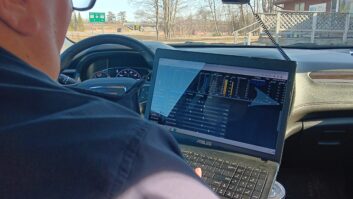Several NRSC heavy-hitters have been to Ibiquity’s Columbia, Md. headquarters for a demo of its new or improved codec.
The set-up provided direct comparison of source material to analog transmission received on a Kenwood auto radio, along with digital transmissions. The digital transmissions were at 98kbps and 64kbps for FM (simultaneous to an Ibiquity reference receiver) and at 98kbps through the air to a Kenwood digital auto radio, said Journal Broadcast Group’s Andy Laird.
For AM, the digital transmission was switched on the reference receiver from enhanced (35kbps) to core (20kbps) with the Kenwood operating through the air in the enhanced mode.
In the Ibiquity AM system, the receiver initially locks onto the signal at “core,” which is mono at 20 kbps, and then builds on core to “enhanced,” which is stereo at 36kbps with improved frequency response, said sources.
All sources said the Texas Instruments DSP chip has enough headroom to handle the software upgrades needed for the new or improved codec, which Ibiquity has yet to publicly identify.
Laird said, “All of my complaints are addressed. The FM system at 98kbps is truly CD- like with all types of programming and the 64kbps is very close.”
For AM, the codec artifacts were “greatly diminished.” He said the improved 20 kbps core is much better than the previous codec at 35 kbps.
“The AM system is now a real pleasure to listen too even with very complex, high quality source material. It has great clarity,” said Laird.
Also of note to broadcasters, he said, “We tested several real world broadcast situations involving ISDN remotes and other bit rate source material. The new Ibiquity codec passes this with very little additional degradation.”
Clear Channel’s Jeff Littlejohn also called the demo “a vast improvement over what we heard previously. The codec had very few artifacts even at 20kbps.”
Greater Media’s Milford Smith, also NRSC DAB Subcommittee Chairman, said, “In my opinion, it’s fixed. On AM, the improvements were spectacular. And FM was significant.”
Other sources said the previous codec, PAC, contained artifacts on AM at low bit rates that were distracting and obvious; so much so that listener fatigue came into play.
Ibiquity’s Mystery Codec Praised
Ibiquity's Mystery Codec Praised












